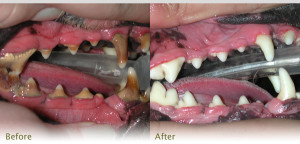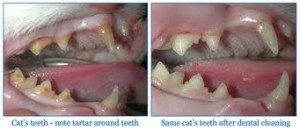It seems like we’re bobsledding, luging or skating our way through February at a record pace! It’s going so quickly that we’re already halfway through Pet Dental Health Month! Have you checked your fur-kids’ teeth yet?! Now is a great time to lift a lip and see just what condition your pet’s teeth, tongue and gums are in. Perhaps you’ll see nice pink gums and pearly whites, but if your pet is like most you’ll probably find a few patches of brown, green, or yellow tartar along the gum line and perhaps even covering the entire tooth. You may see a bright red line at the top of the tooth indicating gingivitis. You might not even be able to see the tooth for the tartar that’s accumulated. Also, you may notice blood or drooling, even very foul odors during your inspection. If you find problems, please see your veterinary care professional so a further assessment can be made.



The question I commonly hear when I lift a lip during exams is, “So what’s the big deal, Doc? Have you seen what my dog eats? Did you know that my cat eats birds and mice?” It’s certainly true that our pets don’t show a lot of dietary discretion and that’s part of the reason we see mouths in such states of decay. Even so, the condition of your pet’s mouth can have a huge impact on overall health. Teeth and gums that show even a mild case of disease are already riddled with many, many different kinds of bacteria. As the periodontal area decays, the bacteria can be picked up in the blood supply and may travel throughout the body. Think of your pet’s mouth as Grand Central Station, the blood supply the train that those little nuisance travelers want to jump, and parts of your pet’s body their final destination. Bacteria are always looking for a nice cozy spot to take up residence and the bacteria that vacation in the mouth are no different. Organs that can be targeted as hot spots from oral infection are the heart, the kidneys, the intestinal tract and the joints. Infection can lead to disease and disease can lead to failure in these essential organ systems. Add to that the pain and discomfort that dental disease itself causes and you can see why it’s important to look after your best friend’s mouth. Dental health is a pretty big deal!!
Once you or your veterinarian has determined that your pet does need a prophylactic dental cleaning, and possibly even extensive dental work, what comes next?
Because our fur-friends aren’t particularly cooperative when we’re trying to look in their mouths, much less scale and/or pull teeth, pet dentistry is done under a general anaesthesia. This can be a scary prospect for many folks and shouldn’t be taken lightly. Your pet’s overall health should be assessed by their doctor prior to the event. A good listen to the heart, a check of joints to make sure there is no swelling, and a proper feel of the abdomen to indicate issues should be performed. Most of the time blood tests will be recommended prior to the procedure to make sure that kidney and liver function, as well as immune function are healthy. If you’re uncomfortable with the thought of anaesthesia, make a list of questions to ask your vet before your have your pet’s teeth cleaned. Caring veterinarians truly strive to minimize the risk to your best friend through the dental procedure.
After your pet is scheduled, they might be placed on antibiotics for a few days prior to the actual visit in order to decrease the bacterial load in the mouth or blood stream. You will be asked to fast them the night before the procedure. This is to decrease the risk of anaesthesia during the cleaning. When you arrive at the hospital, there will typically be a consent form to be completed. Please allow time for this, it’s important!
Following admission, your dog to cat will often be given a mild sedative and then carefully intubated – a procedure that puts a protective tube into the trachea of the pet so they can breathe in anaesthetic gasses without breathing in particles and water released during the cleaning. Following this, a thorough exam of the oral cavity will be performed either by your veterinarian or a certified veterinary technician, just to make sure nothing was missed during the initial visit. Then, let the cleaning begin!
Veterinarians all have different procedures they’ve been taught, but as a general guideline here’s what happens. The teeth are initially scaled. Sometimes, a first round of hand scaling is done to remove very large amounts of tartar. Following this, an ultrasonic scaler is used to remove all of the remaining tarter- that gross and smelly stuff that is covering the tooth surface- in order to expose a clean tooth as well as to flush the gum area. A check of the cleaned tooth surface for cavities- not very common in pets- damage to enamel and even cracks in the tooth follows. Once this has been completed the gums are reassessed for pockets or recession, measurements are made to see how much tooth root might be exposed. Any loose teeth should be extracted at this time. Once these steps are completed, a polishing unit is used to smooth the tooth surface to make adherence of tartar more difficult in the future. The oral cavity is flushed and the mouth is inspected a final time- in our practice by two different people, the certified vet tech and the veterinarian. Your pet will then be slowly awakened from their nap, wrapped in warming sheets and reassured that having a clean mouth really is a good thing! It’s recommended that your fur-kid be monitored for several hours after waking up, just to be safe and to make sure they aren’t too groggy when sent home for post-dental TLC. If the dental was extensive or there was extreme gingivitis, you may be sent home with antibiotics or pain medication that should be administered for several days post-dental cleaning. Please follow through with this. Remember, those nasty travelers/bacteria might still be on the train to your pet’s organs. We want to stop them on the track! Occasionally if there was severe dental disease, you may be be asked to bring Fido or Fluffy back in a few days, just to make sure everything is healing nicely.


For long term care, it is highly recommended that you brush your pet’s teeth on a regular basis, preferably daily! Dogs are a little easier than cats because the brushing can be supplemented by chewing treats and approved ‘bones’ such as deer antlers, hard sterilised bones and Nylabones. Please be sure to monitor your kid when they are chewing; remember that choking can always be a hazard! For cats there are tartar treats and additives to food and water that may be helpful in maintaining tooth and gum health between dental cleaning visits. As a general rule, most pets over the age of three need annual dental exams and cleanings. Sometimes, certain breeds need more diligent care. Remember how important this is in your pet’s overall health!
So this month, and every month after, as you take the time to check Fido’s 42 chompers, or Sylvester’s 30 teeth, keep in mind you are doing them a great service!!!
